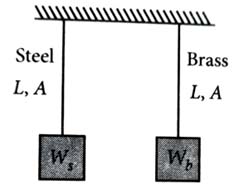Topic Question Set
Q 1
:
The maximum elongation of a steel wire of 1 m length if the elastic limit of steel and its Young's modulus, respectively, are and , is [2024]
4 mm
0.4 mm
40 mm
8 mm
(1)
Here,
Young’s modulus and Stress
Q 2
:
Let a wire be suspended from the ceiling (rigid support) and stretched by a weight attached at its free end. The longitudinal stress at any point of cross-sectional area A of the wire is [2023]
-
Zero
-
-
(4)
Longitudinal stress is the normal stress which changes the length of the body, it is given by

Q 3
:
Given below are two statements: One is labelled as Assertion (A) and the other is labelled as Reason (R).
Assertion (A): The stretching of a spring is determined by the shear modulus of the material of the spring.
Reason (R): A coil spring of copper has more tensile strength than a steel spring of same dimensions.
In the light of the above statements, choose the most appropriate answer from the options given below: [2022]
Reason (R): A coil spring of copper has more tensile strength than a steel spring of same dimensions.
Both (A) and (R) are true and (R) is the correct explanation of (A)
Both (A) and (R) are true and (R) is not the correct explanation of (A)
(A) is true but (R) is false
(A) is false but (R) is true
(3)
The stretching of a coiled spring is determined by its shear modulus because neither its length nor its volume changes but only the shape of the spring is changed. Elasticity of steel is more than copper.
Q 4
:
A wire of length , area of cross section is hanging from a fixed support. The length of the wire changes to when mass is suspended from its free end. The expression for Young’s modulus is [2020]
(4)
Given : initial length = L, area of cross section = A
New length after mass M is suspended on the wire = L
Change in length,
Now Young's modulus,
Q 5
:
Two wires are made of the same material and have the same volume. The first wire has cross-sectional area A and the second wire has cross-sectional area 3A. If the length of the first wire is increased by on applying a force F, how much force is needed to stretch the second wire by the same amount? [2018]
(1)
Young's modulus,
Since initial volume of wires are same and their areas of cross-sections are A and 3A, so lengths are and respectively.

For wire 1,
...(i)
For wire 2, let force be applied,

...(ii)
From equations (i) and (ii),
Q 6
:
The bulk modulus of a spherical object is . If it is subjected to uniform pressure , the fractional decrease in radius is [2017]
(3)
Bulk modulus is given as
...(i)
The volume of a spherical object of radius is given as
Put this value in eqn. (i), we get
Fractional decrease in radius is
Q 7
:
The Young’s modulus of steel is twice that of brass. Two wires of same length and of same area of cross section, one of steel and another of brass are suspended from the same roof. If we want the lower ends of the wires to be at the same level, then the weights added to the steel and brass wires must be in the ratio of [2015]
4 : 1
1 : 1
1 : 2
2 : 1
(4)

Let and be the length and area of cross-section of each wire. In order to have the lower ends of the wires to be at the same level (i.e. same elongation is produced in both wires), let weights and are added to steel and brass wires respectively. Then, by definition of Young’s modulus, the elongation produced in the steel wire is
and that in the brass wire is
But (given)
As
Q 8
:
The approximate depth of an ocean is 2700 m. The compressibility of water is and density of water is . What fractional compression of water will be obtained at the bottom of the ocean? [2015]
(1)
Depth of ocean,
Density of water,
Compressibility of water,
Excess pressure at the bottom,
We know,
Q 9
:
Copper of fixed volume is drawn into wire of length . When this wire is subjected to a constant force , the extension produced in the wire is . Which of the following graphs is a straight line? [2014]
versus
versus
versus
versus
(2)
As ...(i)
where is the area of cross-section of the wire.
Young’s modulus,
Hence, the graph between and is a straight line.

